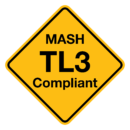Brifen MASH wire rope safety barrier provides safe vehicle containment and redirection, utilising the tensile strength of tensioned wire rope supported by steel posts. The unique weave pattern of Brifen limits dynamic deflection and produces low occupant risk ride down decelerations.
The system is anchored with non-release terminals and may be installed on the shoulder (verge) or in the median to prevent dangerous cross-over accidents.



